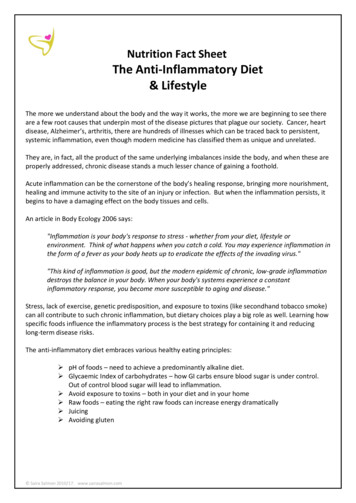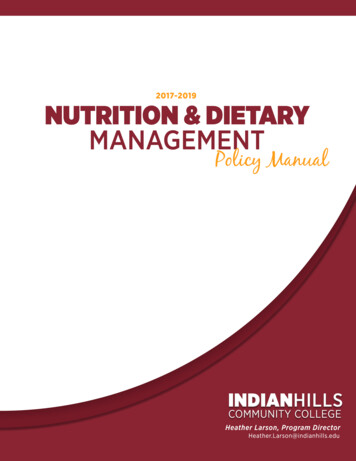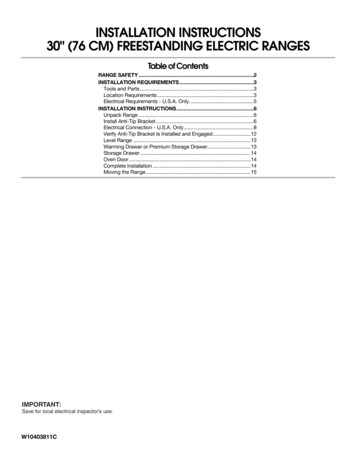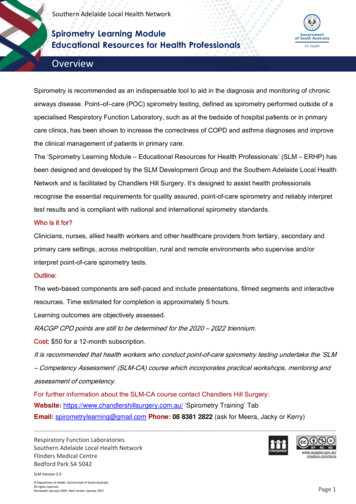
Transcription
Nutrition Fact SheetThe Anti-Inflammatory Diet& LifestyleThe more we understand about the body and the way it works, the more we are beginning to see thereare a few root causes that underpin most of the disease pictures that plague our society. Cancer, heartdisease, Alzheimer’s, arthritis, there are hundreds of illnesses which can be traced back to persistent,systemic inflammation, even though modern medicine has classified them as unique and unrelated.They are, in fact, all the product of the same underlying imbalances inside the body, and when these areproperly addressed, chronic disease stands a much lesser chance of gaining a foothold.Acute inflammation can be the cornerstone of the body’s healing response, bringing more nourishment,healing and immune activity to the site of an injury or infection. But when the inflammation persists, itbegins to have a damaging effect on the body tissues and cells.An article in Body Ecology 2006 says:"Inflammation is your body's response to stress - whether from your diet, lifestyle orenvironment. Think of what happens when you catch a cold. You may experience inflammation inthe form of a fever as your body heats up to eradicate the effects of the invading virus.""This kind of inflammation is good, but the modern epidemic of chronic, low-grade inflammationdestroys the balance in your body. When your body's systems experience a constantinflammatory response, you become more susceptible to aging and disease."Stress, lack of exercise, genetic predisposition, and exposure to toxins (like secondhand tobacco smoke)can all contribute to such chronic inflammation, but dietary choices play a big role as well. Learning howspecific foods influence the inflammatory process is the best strategy for containing it and reducinglong-term disease risks.The anti-inflammatory diet embraces various healthy eating principles: pH of foods – need to achieve a predominantly alkaline diet. Glycaemic Index of carbohydrates – how GI carbs ensure blood sugar is under control.Out of control blood sugar will lead to inflammation. Avoid exposure to toxins – both in your diet and in your home Raw foods – eating the right raw foods can increase energy dramatically Juicing Avoiding gluten Saira Salmon 2010/17. www.sairasalmon.com
Why is Body PH Important?The human body is naturally slightly alkaline. For optimum health clinical trials have proved that analkaline body is healthier than an acidic body, and in order to be in reasonable health your blood andcells must be slightly alkaline. Regularly eating too much acid-forming food challenges the body’s abilityto maintain this optimum balance.We eat food to provide the fuel, or energy, for our various body systems to carry out the functions ofliving. In order to do this food is ‘burnt’ with oxygen to produce the energy. Much as a fire leaves ash,this process produces an internal ‘ash’. Depending on the type of fuel this will be alkaline, acidic orneutral in nature. When acidic residues accumulate this starts to cause the body problems.What Does the Body Do?The main ways the body tries to rid itself of this toxic acid residue is through urine, faeces, sweat andexhaled breath. However, when these systems become swamped by a highly acidic diet the bodyreverts to storing what cannot be processed.The body will always do the best it can for you given the circumstances it finds itself in. When it isoverwhelmed with acidic waste from your diet and lifestyle and the required acid/alkaline balanceneeded to maintain life is under threat, it will change acidic waste into solids and store them, forexample as LDL cholesterol (the harmful cholesterol), as adipose tissue (fat), and uric acid (prime causeof kidney and gallstones and gout). This helps contain the threat to your body although these wastesare a major contribution to both ageing and degenerative diseases.A diet high in alkaline-forming foods helps the body to cleanse itself of acid residues and work its wayback to good health. The human animal evolved to function optimally on a diet comprised of 80%alkaline foods and 20% acid – and this is exactly what formed the diet of the majority up until the lastcouple of hundred years. Now the opposite is true – the standard Western diet is now 80% acidic and20% alkaline. Our bodies are struggling – and all too often failing – to adapt.Examples of common dietary habits which contribute to acid overload are: a high protein diethigh levels of alcohollow levels of fruit and vegetableslots of refined and processed foods eg. bread, sugarWhat is Acidosis?Acidosis is a condition of having too much acid in your body. The body – ever inventive and alwaysworking for survival – has established means of dealing with excess acidity. The minerals calcium,magnesium and potassium, usually found in fruit and vegetables, are acid buffers. The more of thesewe eat the more helpful any diet becomes in aiding the body to detox the acidity. When our diet isdeficient in these minerals, as many peoples are, the body still needs to buffer the excess acidity but hasto ‘borrow’ the minerals from body stores – usually from vital organs and bones. In the long term thebody can suffer severe and sustained damage from this process, but it can be years before this isdetected. Saira Salmon 2010/17. www.sairasalmon.com
Acid forming foods are inflammatory in their effect on the body and symptoms of acidosis include suchthings as: low energy and fatiguepoor skinweak, brittle nails, dull hair and skindifficulty in losing weight, obesityaching muscles and joints; rheumatoid and osteoarthritis, gout, fibromyalgiaosteoporosis, weak brittle bones and bone spurskidney and gall stonesbladder and kidney problemspremature lines and wrinklesskin problems such as acne, eczema, psoriasisfrequent infections caused by a compromised immune system yeast infections fungal infections parasitical infections bacterial infections viral infections poor concentration and forgetfulness type II diabetesWhat Can I Do About It?By switching the balance of your diet back to 80% alkaline and 20% acid-forming foods you can graduallybegin to alkalize your body. This process will enable your body to begin to clear itself of stored acidwaste residues and as these start to be cleansed the symptoms caused will start to dissipate and you willbegin to restore yourself to good health.Refer to the following table of acid and alkaline forming foods to guide you- this refers to the type ofresidue a food leaves in the body once it is burnt. Not everything which tastes acidic remains acidicafter digestion – lemons being a good example of an alkalinizing food which tastes acidic. Saira Salmon 2010/17. www.sairasalmon.com
Acid-Forming FoodsFoodCategoryVegetablesBeans &LegumesMost AcidAcidFruitsBlueberriesCranberriesPrunesGlazed fruitsSour cherriesRhubarbGooseberriesNuts tatos(withoutskins)Pinto beansNavy beansLima beansOilsAlkaline-Forming CornLentilsWinterSquashBlack beansChick peasPlumsProcessedfruit ParsleyRaw tCeleryLettuceCourgettesSweetpotatosCarobLemons &limesWatercressGrapefruitMangosOlivesDried SunflowerseedsCorn oilPoppy ondsBrazil nutsHazel nutsPine kernelsFlaxseed oilGrains &cerealsWheatWhite flourCakes &pastriesWheat pastaWhite riceCornBuckwheatOatsRyeSproutedwhitebreadSpelt flourBrown riceMeats ilkCreamHerringsMackerelTurkeyChickenLambRaw milkEggsVenisonCold-waterfishEggs &Dairy Saira Salmon 2010/17. www.sairasalmon.comEggs(organic)ButterYoghurtOlive oilMostAlkalineCarrotsTomatosFresh cornMushroomsCabbagePeasPotato skinsOlivesSoya cadoCoconut,freshWatermelonChestnutsCanola oilAmaranthMilletWild riceQuinoaSoured dairy Breast milkproductsRice milkAlmondmilkSoya cheeseSoya milkGoats milkGoats
Past. watersCranberryjuiceCarton fruitjuicesButtermilkCottagecheeseDecaffeinated Black teaor weakEarl greycoffeeNut milksTea withmilk/sugarSpritzersCarton fruitjuices dilutedby 50% rmesetasCandarelWhite sugarBrown sugarSpicesSaltPepperVinegarHot spicesPeanut eyHerb teasGreen teaJam – sugarfreeVanilla pods& essencePure fruitjuicesRooibus teaGinger teaVegetable/BouillondrinksFreshtomatojuiceStill mineralwaterWaterHot lemonLemonwaterFruit teasHome-madefruit juicesAqua LibraGreen juicesVeggie juicesAlkalineanti-oxidantwaterMaple syrup Raw honeyRaw sugarMisoTamariShoyuTahiniApple cidervinegarBee pollenLecithingranulesProbioticculturesWhat is Glycaemic Index?Glycaemic Index (GI) is based on maintaining a stable blood sugar level in order to prevent food cravingsand the need for quick energy boosts, which in turn lead to weight gain. Unstable blood sugar levels inthe long term will lead to the build-up of inflammation in the body.The Principle of GIThe principle of GI is very simple. When you eat a food with a high GI, the sugars in the food arereleased quickly into the blood stream in the form of glucose. Excess glucose in the blood can be verydamaging to the body, so it immediately releases insulin into the blood in order to remove the excessglucose. It has to do something with this glucose and stores it as fat against future energy needs of thebody. Fine so far, but the large surge in insulin triggered by eating a high GI food also starts reactions inthe body which leave you feeling lethargic, hungry and craving another glucose hit once the glucose isout of your blood stream – so you reach for another snack. The stored glucose is never used for energyand the weight gain continues. Saira Salmon 2010/17. www.sairasalmon.com
Eating a food with low GI on the other hand means that there is a slow steady release of the sugarcontent, and therefore only a slow steady release of glucose into the bloodstream. This does not triggerthe release of insulin, with the associated problems outlined above.What is Glycaemic Load? Is it different?Sometimes you see it referred to as Glycaemic Load (GL) not GI. Is this different. Well, yes and no.Glycaemic load (GL) takes the principle of GI a step further by measuring the amount of simple andcomplex sugars in a carbohydrate (GI) as well as the quality of the carbohydrate. This has the effect ofironing out some of the obvious anomalies in the system ie. carrot and chocolate have similar GI scores,but carrots have a low GL score, which is more in line with what you would expect.The Glycaemic Table available from myself includes both ways of looking at carbohydrates.ToxinsWe live in a toxic world, and all of us are exposed to both environmental and metabolic toxins everyday. To a very large extent the metabolic toxins are familiar to our body, and it has mechanisms to dealwith them – although they can become overwhelmed, stagnant or damaged.It is the environmental toxins – or those we bring into our body, from exposure through skin, breathing,diet etc that we really have to worry about. We are exposed to a vast array of chemicals now in a waynever seen before in man’s evolution. Test done on fat cells from an Ancient Egyptian mummy showedzero levels of these toxins, whilst almost every one of us today, if we had a similar test done on us,would find we had tens, if not hundreds of different chemicals in our blood and fat cells.Minimising our exposure to these, and the potential damage they can do is important, as these toxinscan be an underlying cause of inflammation. The principles are simple:Wherever possible eat an organic diet to avoid pesticide and herbicide residues.Buy only chemical-free, natural based toiletries and personal care products – there are manygood ranges available.Use only environmentally-friendly household products – many standard cleaning products areextremely hazardous.Garden organically – avoid chemical-based garden spraysUse environmentally-friendly paints and paint finishes wherever possible due to off-gassing.There are many other areas of exposure, but these are the ones you can do most about, and covers themajority of exposure to these type of toxins for most of us.Raw FoodsWhole and unprocessed raw and living foods can give a real boost to your health and energy levels.Leafy greens, wheatgrass, sprouted seeds, grains, seaweeds, green juices, smoothies – there are lots ofways of accessing these alkaline-rich, nutrient rich foods, which also contain full levels of enzymes asthey haven’t been cooked. Saira Salmon 2010/17. www.sairasalmon.com
One of the downsides of heating food over 120 C is that is kills of beneficial enzymes in the food,making them harder to digest. It can also affect the pH of certain foods – tomatoes are very alkaline forexample when raw, but acidic when cooked.Also very important from an anti-inflammatory point of view is that raw and living foods are the mostalkaline, oxygen-rich foods we can eat. The more oxygen-rich our internal environment is, the morenasties like cancer cells will have a chance to form. Dr Otto Warburg who won the Nobel Prize for hisstudies on the metabolism of cancer cells said “Cancer has only one prime cause. It is the replacementof normal oxygen respiration of the body’s cells by an anaerobic (oxygen-deficient) cell respiration.” Ie.cancer cells thrive in an oxygen-depleted environment.JuicingJuicing is a great way to start the day, and can give your body and alkaline, cleansing boost as well as ashot of raw energy. It can really help to nourish your cells, boost your immune system and keep up thecleansing. Vegetable based juices in particular are good for this as they contain minimal sugar – fruitbased juices are more likely to affect blood sugar levels.There are lots of different juice combinations you can do. The trick is to experiment and find what youlike best. Almost anything can go in a juicer so it really comes down to taste. Be warned though – yourtaste buds will change, the cleaner you get. Wheat grass doesn’t taste so good to an acid body, but analkaline body loves it! So if you find green drinks yukky, this could be a sign you really need them!Juicers can range from very expensive to very cheap. Find something in your price range, buy a varietyof fruit and vegetables (organic of course!) and have a go!Avoiding GlutenGluten intolerance can be a major cause of inflammation, as well as a whole host of other symptomsand generally feeling lousy. Sensitivity to gluten – which is found in the grains wheat, rye and barley –can be the culprit behind digestive problems such as bloating, cramps, diarrhea, fatigue, achy joints, andeven skin rashes. The more sensitive these and other symptoms are felt.If your body is at all sensitive to gluten it will react against it whenever you eat gluten – this reaction willcause an inflammatory response, which, because you keep eating it, carries on happening. Many peoplewho are gluten-sensitive are unaware of this fact, so they chalk their symptoms up to irritable bowel,depression, stress or many other causes.Common symptoms of gluten intolerance include:DiarrheaFoul smelling stoolsIrritabilityMuscle crampsFatigueAbdominal painAnaemiaJoint PainSkin rashesNeuropathyBloating and windDepressionMouth SoresOsteoporosisThere is a simple way to find out if gluten is not your friend – stop eating it for several weeks and thensee how it feels when you do re-introduce it. Ideally, you will be gluten-free for three weeks, as it cantake this long to get the effects of gluten out of your body. Saira Salmon 2010/17. www.sairasalmon.com
Gluten is found in every single form of wheat including durum wheat, pasta, cous cous, spelt, kamut,einkorn, farro, and bulger. Other grains which contain it include rye, barley and triticale. Wheat hasthe most gluten, and some people are sensitive to wheat, but deal ok with rye and barley as theycontain much less gluten.There are plenty of other grains you can use – brown rice, amaranth, wild rice, corn, buckwheat, milletand quinoa. Oats are also ok for many people, although cross contamination from a processing plantcan sometimes be a problem. And don’t forget – fruit and vegetables, nuts and seeds are all gluten-freeso you can fill up on those!Other Things You Need To KnowUnder the pH principles you want to have a diet that is approximately 80% alkaline to 20% acid in itsmakeup, so protein foods such as meat and fish, and even some dairy is fine to make up the 20%. Herethe tip is to buy the best quality you can afford. The optimum is grass-fed organic meat, and nonfarmed fish. It is hair-raising to read about the intensive farming practices that are normal for factoryfarmed meat animals, from non-natural diets, to never seeing a green field or open air, shot full ofhormones and antibiotics and being highly stressed. All of this affects the quality of the meat, isretained by the meat and is not beneficial to you.Processed food does not feature as a part of this way of eating as most processed food is of poornutritional value, contains additives of various descriptions and often take more energy to digest thanthey provide.Avoid polyunsaturated fats (PUFAs) – this are made from vegetable oils, and are usually highly damagedand detrimental. They are found in anything from margarine and spreads to canola oil, rapeseed oil,corn oil etc. They are also found in most processed foods.Another avoid is sugar – this will incite inflammation in the body and made any problems worse.Digestive health is important, and if you do not have good digestion, are prone to bloating and wind,constipation, diarrhea or any other problems like this, you need to see someone to get things sortedout. Gut balance is vital to overall health.Supplements can really help you with what you need to achieve – particularly as there are plenty ofstudies which show us that even those with great diets are unlikely to get 100% of their nutritionalrequirements these days from diet alone.Clean, mineral-rich water is important – tap water, with all its chemical, drug residues, nitrates etc doesnot really fit the bill. Filtered water is often your best choice (although it will require a reverse osmosisfilter to remove drug residues, a carbon filter is not fine enough), unless you have access to deep springwater that has been tested free of chemicals such as nitrates.Fermented foods such as kombucha tea, kefir, sauerkraut, yogurt, fermented vegetables, and applecider vinegar are all excellent examples of probiotic-rich superfoods that will help to populate your gutwith beneficial bacteria, and ensure that your digestive tract remains healthy and well-functioning aswell as helping prevent harmful pathogens from entering your body. Saira Salmon 2010/17. www.sairasalmon.com
StressOne last thing you need to be aware of is the part that stress plays in both changing the acid-alkalinebalance in the body, and in maintaining an inflammatory state within the body.Stress comes in many shapes and forms and it can be very individual, but whether it is emotional,physical, mental etc it all has the same impact on the body.Finding ways to mitigate stress by exercise, meditation, yoga, lifestyle changes etc is an essential part ofan anti-inflammatory lifestyle. Some supplements can help to mitigate some of the effects of stress, butthese alone will not be sufficient. Saira Salmon 2010/17. www.sairasalmon.com
The anti-inflammatory diet embraces various healthy eating principles: pH of foods – need to achieve a predominantly alkaline diet. Glycaemic Index of carbohydrates – how GI carbs ensure blood sugar is under control. Out of contro










